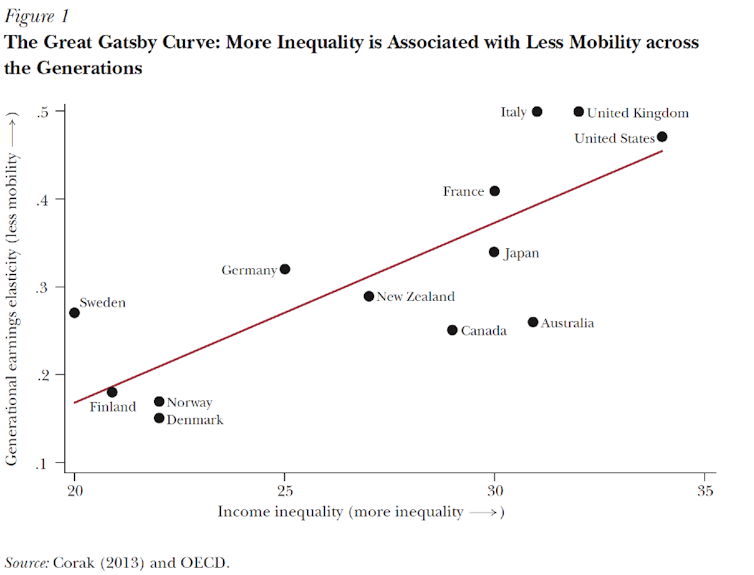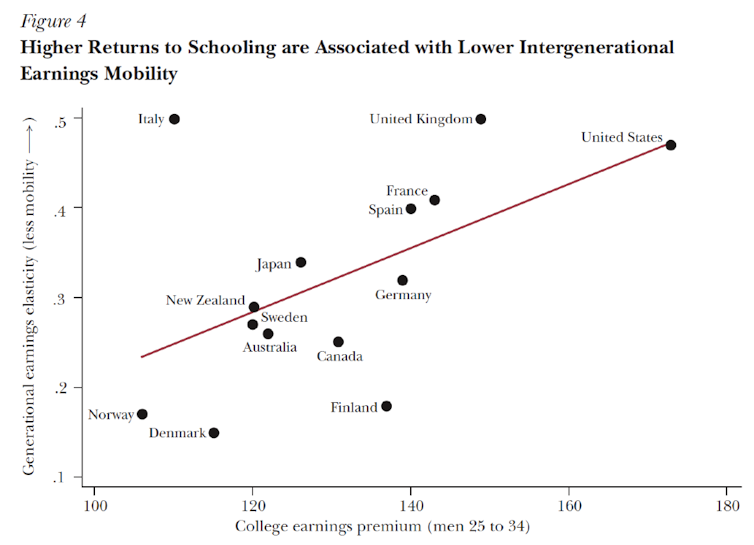In this, the first of a two-part series on inequality and university education in Australia, University of Canberra Vice-Chancellor Stephen Parker argues that rather than redress inequality, universities actually exacerbate it. Part two, tomorrow, suggests 10 ways to fix the problem.
In the last 50 years higher education has expanded, but so has social inequality. There is a causal connection, one which can be reduced or dismantled to some extent.
The Gini coefficient is a useful starting point to measure inequality. If all the income of a group were shared equally, there would be perfect equality and the coefficient would be 0. If it were all owned by one person, the coefficient would be 1.
In the last 20 years, Australia’s inequality has been rising at around the OECD average, but now we are above it. We have greater income equality than the UK but much less than Denmark.
Income inequality began to rise after 1980, in what Tony Atkinson has called The Inequality Turn.
Wealth inequality has been growing faster than income inequality and is considerably worse. The average wealth of an Australian household in the top 20% is around 70 times the average wealth of a household in the bottom 20%.
The greater the inequality in a society, the less social mobility there seems to be across the generations: graphically described as The Great Gatsby Curve.

Recently, there are at least suggestions that inter-generational mobility in Australia is declining. I believe it might have stalled.
But what has this got to do with higher education?
The better your parents are educated, the more likely you are to graduate from university. Simon Marginson, in line with other studies, estimates that a young person in Australia is 4.3 times more likely to participate in tertiary education if one of their parents was tertiary-educated than a young person whose parents had less than upper secondary education.
If the economy increasingly rewards graduates, and only 30% to 40% of young people go to university, then over time they will tend to move ahead of the other 60% to 70%.
Thus, income inequality increases, with the affluent accumulating more property and superannuation, which they pass onto their children, so that wealth inequality increases.
The following graph, if valid, is profoundly disturbing.

In countries where a degree buys more earning power there is less upward mobility over the generations. In Norway, for example, the premium on a degree is less, and longitudinal studies show that there is less relationship between parental earnings and those of their child: the younger generation largely starts again. At the other end of the scale is the US, where a degree is worth more and social mobility is less. If the Australian education becomes more Americanised, we risk the same situation.
But universities don’t control the drivers of earnings inequality such as the tax transfer system and the minimum wage level. Nor do we control global capitalism, the knowledge economy and the demand for ever-increasing skill levels. We are caught up in a system that places a high value on a degree.
What we can do, however, is help distribute more evenly the spoils of higher education and disrupt the patterns of inherited advantage, which increasingly divide society. To understand them, however, we need first to understand how advantage is transmitted through education and how stratification comes about within education.
Parental education levels typically influence not only whether a child attends university at all, but also the type of university attended. If one parent went to university rather than reached Year 12 only, then it is more likely that their child will graduate from a Group of Eight research-intensive university. Other universities pick up more first-in-family students.
Low-SES students are distributed unevenly among different types of institutions, a situation that is well-documented, although probably worse in the UK.
In Australia, the Group of Eight universities have the lowest percentage of low-SES students, followed by the Australian Technology Network universities. The distributions of low-SES students according to university type have not changed much since at least 2007. Of the change that there has been, it is the rural and regional universities that have done most of the heavy lifting, followed by the outer urban universities.
This will do more than just make the sector “look” better. It will disrupt a spiralling effect whereby elites move further and further ahead of the others because of the way they use the higher education sector. The argument is this.
When technological change accelerates, governments expand higher education to upskill the workforce. Only when demand from the upper and middle classes has been satisfied does access by lower-class people seem to expand (the “maximally maintained inequality theory”). They are, at present, disproportionately represented in lower-status universities. And because the rich dominate elite institutions, this will accentuate and entrench hierarchy among places, moving the rich relatively further up the distribution.
Then, as technological change slows down for a while, but higher education still has the momentum to keep expanding (which is arguably the case at present), the premium on a degree declines. Competition for prestigious places intensifies as privileged elites seek to consolidate their position in a toughening market. They pay for the most expensive schooling, secure access to the most prestigious universities and, if necessary, invest in graduate study.
Then, when technology takes off again, those elites are best placed to take advantage of the new economic order, and social divergence increases further.
It is a pump inflating inequality. We are in real danger of returning to a situation when the son or daughter of poor parents who lack tertiary qualifications has no realistic prospect of entering a prestigious profession or a secure, well-remunerated career. They might as well hope they have a long-lost distant relative who bequeaths them all their money, or “marry up” if they can, as in Jane Austen’s day.
Tomorrow, part two: what universities must do to redress inequality.

